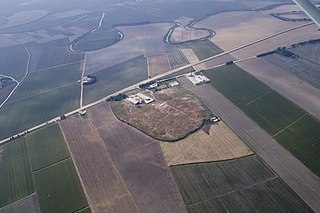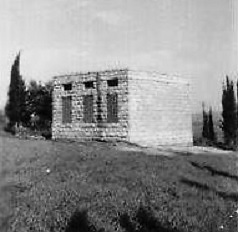
Mehrgarh is a Neolithic archaeological site situated on the Kacchi Plain of Balochistan in Pakistan. It is located near the Bolan Pass, to the west of the Indus River and between the modern-day Pakistani cities of Quetta, Kalat and Sibi. The site was discovered in 1974 by the French Archaeological Mission led by the French archaeologists Jean-François Jarrige and his wife, Catherine Jarrige. Mehrgarh was excavated continuously between 1974 and 1986, and again from 1997 to 2000. Archaeological material has been found in six mounds, and about 32,000 artifacts have been collected from the site. The earliest settlement at Mehrgarh—located in the northeast corner of the 495-acre (2.00 km2) site—was a small farming village dated between 7000 BCE and 5500 BCE.

Tell Ta'yinat is a low-lying ancient tell on the east bank at the bend of the Orontes River where it flows through the Amuq valley, in the Hatay province of southeastern Turkey about 25 kilometers south east of Antakya, and lies near Tell Atchana, the site of the ancient city of Alalakh. Tell Ta'yinat has been proposed as the site of Alalaḫu, inhabited in late 3rd millennium BC, mentioned in Ebla's Palace G archive; and in later times as Kinalua, the capital city of an Iron Age Neo-Hittite kingdom.

The Painted Grey Ware culture (PGW) is an Iron Age Indo-Aryan culture of the western Gangetic plain and the Ghaggar-Hakra valley in the Indian subcontinent, conventionally dated c.1200 to 600–500 BCE, or from 1300 to 500–300 BCE It is a successor of the Cemetery H culture and Black and red ware culture (BRW) within this region, and contemporary with the continuation of the BRW culture in the eastern Gangetic plain and Central India.
Tepe Sialk is a large ancient archeological site in a suburb of the city of Kashan, Isfahan Province, in central Iran, close to Fin Garden. The culture that inhabited this area has been linked to the Zayandeh River Culture.

Bhirrana, also Bhirdana and Birhana, is an archaeological site, located in a small village in the Fatehabad district of the north Indian state of Haryana. Bhirrana's earliest archaeological layers predates the Indus Valley civilisation times, dating to the 8th-7th millennium BCE. The site is one of the many sites seen along the channels of the seasonal Ghaggar river, thought by some to be the Rigvedic Saraswati river.

Pandu Rajar Dhibi in the valley of the river Ajay is an Archaeological site in Ausgram II block in the Sadar North subdivision of Purba Bardhaman district in the Indian state of West Bengal. It was the first Chalcolithic site discovered in West Bengal. It was excavated by a team led by Paresh Chandra Dasgupta. The common man believes that the main mound at Pandu Rajar Dhibi is associated with King Pandu mentioned in the epic Mahabharata, hence the name came into being from the folklore.
Dihar is a village and an ancient archaeological site of great antiquarian importance brought into the limelight by Maniklal Sinha. Located in the Bishnupur subdivision of the Bankura district in the Indian state of West Bengal. It is 8 kilometres (5.0 mi) north of Bishnupur and is near Dharapat.

Abu Zurayq is an archaeological site located on the western edge of the Jezreel Valley and its transition to the Menashe Heights, next to Highway 66, between the modern kibbutzim of HaZore'a and Mishmar HaEmek.

The Shengavit Settlement is an archaeological site in present-day Yerevan, Armenia located on a hill south-east of Yerevan Lake. It was inhabited during a series of settlement phases from approximately 3000 BC cal to 2500 BC cal in the Kura Araxes (Shengavitian) Period of the Early Bronze Age and irregularly re-used in the Middle Bronze Age until 2200 BC cal. The town occupied an area of six hectares. It appears that Shengavit was a societal center for the areas surrounding the town due to its unusual size, evidence of surplus production of grains, and metallurgy, as well as its monumental 4 meter wide stone wall. Three smaller village sites of Moukhannat Tepe, Khorumbulagh, and Tairov have been identified and were located outside the walls of Shengavit. Its pottery makes it a type site of the Kura-Araxes or Early Transcaucasian Period and the Shengavitian culture area.

Tell Qaramel is a tell, or archaeological mound, located in the north of present-day Syria, 25 km north of Aleppo and about 65 km south of the Taurus mountains, adjacent to the river Quweiq that flows to Aleppo.

Tell Sabi Abyad is an archaeological site in the Balikh River valley in northern Syria. It lies about 2 kilometers south of Tell Hammam et-Turkman.The site consists of four prehistoric mounds that are numbered Tell Sabi Abyad I to IV. Extensive excavations showed that these sites were inhabited already around 7500 to 5500 BC, although not always at the same time; the settlement shifted back and forth among these four sites.
The Little Egypt site was an archaeological site located in Murray County, Georgia, near the junction of the Coosawattee River and Talking Rock Creek. The site originally had three platform mounds surrounding a plaza and a large village area. It was destroyed during the construction of the Dam of Carters Lake in 1972. It was situated between the Ridge and Valley and Piedmont sections of the state in a flood plain. Using Mississippian culture pottery found at the site archaeologists dated the site to the Middle and Late South Appalachian culture habitation from 1300 to 1600 CE during the Dallas, Lamar, and Mouse Creek phases.
Sanganakallu is an ancient archaeological site from the Neolithic period. It is approximately 8 km from Bellary in eastern Karnataka. It is a group of hills south of a horseshoe shaped valley, with Kupgal to the north. It is one of the earliest settlements in South India, spread over 1,000 acres. There is a layer of red-brown fossilized soil spread over Sanganakallu and Kupgal that can be dated back to 9000 BC. The site is considered to be a neolithic factory site due to the surface excavation revealing large numbers of pottery, stone axes, and other stone tools. The site was first majorly excavated in 1946, by Bendapudi Subbarao, on Sannarasamma hill. Subbarao divided their culture into 3 phases:
Periano Ghundai meaning "The Hill of Fairies" was an archaeological mound located in the Zhob district in Balochistan, Pakistan. The site is located 3 kilometres (1.9 mi) west of the town of Zhob. It was excavated in 1924 by Sir Aurel Stein and showed great resemblance to the Harappan culture.
Tell Judaidah is an archaeological site in south-eastern Turkey, in the Hatay province. It is one of the largest excavated ancient sites in the Amuq valley, in the plain of Antioch. Settlement at this site ranges from the Neolithic through the Byzantine Period.

Sang-i Chakmak is a Neolithic archaeological site located about 1 km (0.62 mi) north of the village of Bastam in the northern Semnan Province of Iran, on the southeastern flank of the Elburs Mountains. The site represents quite well the transition from the aceramic Neolithic phase in the general area; this was taking place during the 7th millennium BC.

Sohr Damb, c. 3800–2300 BC, is an archaeological site, located near Nal, in central Balochistan, Pakistan that begins before the Indus Valley civilization featuring Togau, Kili Ghul Mohammad, and Kechi Beg pottery styles. It has also been known as Naal, Balochistan, and gave its name to the prehistoric Amri-Nal culture, which is attributed to the dual typesites of Amri and Nal.
Hiwassee Island, also known as Jollys Island and Benham Island, is located in Meigs County, Tennessee, at the confluence of the Tennessee and Hiwassee Rivers. It is about 35 mi (56 km) northeast of Chattanooga. The island was the second largest land mass on the Tennessee River at 781 acres before the Tennessee Valley Authority created the Chickamauga Lake as a part of the dam system on the Tennessee River in 1940. Much of the island is now submerged, leaving 400 acres above the waterline.
Early Agricultural Communities in Bengal were a group of Chalcolithic farmers, who first developed agriculture in Bengal. No archaeological evidence of large-scale agriculture in Bengal during the Neolithic period preceding the Chalcolithic or Copper Age.
Bharatpur is an archaeological site of Early village farming culture located in the Indian state of West Bengal. Construction of the settlement is believed to have started around 1735–1417 BC.












